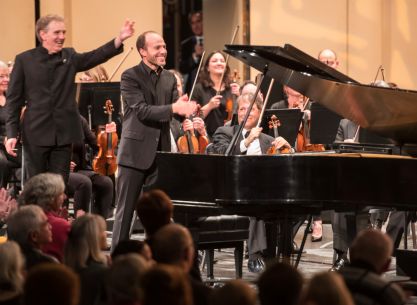|
Symphony
FROM THE NEW WORLD TO THE OLD WORLD
by Peter Lert
Saturday, June 14, 2025
Chamber
MC2 DUO RECITAL CLOSES 222'S SEASON
by Terry McNeill
Saturday, June 14, 2025
Choral and Vocal
CANTIAMO SONOMA'S LUSCIOUS A CAPELLA SINGING IN SEASON ENDING CONCERT
by Pamela Hicks Gailey
Sunday, June 8, 2025
Symphony
SRS SEASON ENDS WITH RESOUNDING TA-TA-TA-BANG
by Terry McNeill
Sunday, June 1, 2025
Symphony
YOUTHFUL VIRTUOSITY ON DISPLAY AT USO'S MAY CONCERTS
by Peter Lert
Saturday, May 17, 2025
Symphony
MYSTICAL PLANETS AND LIVELY GERSHWIN ORTIZ AT FINAL SRS CONCERT
by Peter Lert
Sunday, May 4, 2025
Symphony
VSO'S CONCERT MUSIC OF TIME, MUSIC OF PLACE
by Peter Lert
Sunday, April 27, 2025
VOCAL ELEGANCE AND FIRE AT THE 222'S RECITAL APRIL 26
by Pamela Hicks Gailey
Saturday, April 26, 2025
CANTIAMO SONOMA SINGS AN INSPIRED GOOD FRIDAY MOZART REQUIEM CONCERT
by Pamela Hicks Gailey
Friday, April 18, 2025
DRAMATIC SHOSTAKOVICH SYMPHONY CLOSES PHILHARMONIC'S 25TH SEASON
by Terry McNeill
Sunday, April 13, 2025
|
 |
 Alasdair Neale (l) and Orion Weiss Celebrate Jan. 26 (Stuart Lirette Photo) |
ECLECTIC PASSIONATE PROGRAMMING AT MARIN SYMPHONY CONCERT
by Abby Wasserman
Saturday, January 26, 2019
The Marin Symphony’s second Masterworks concert of the 2018-19 season featured works by John Adams, Sibelius and Brahms, a masterful assembly. In a spoken introduction before the program’s first half, conductor Alasdair Neale primed the audience for the “terra incognita” of Adams’ The Chairman Dances and Sibelius’ Symphony No. 7. The more familiar Brahms Piano Concerto No. 2 occupied the entire second half, with soloist Orion Weiss.
The Chairman Dances was composed in the 1980s while Adams worked on the opera Nixon in China, and is a thoroughly intriguing and delightful piece, playful and whimsical at turns, with minute tonal shifts and compelling rhythms that highlighted the orchestra’s excellent percussionists (Kevin Neuhoff and Ward Spangler) and string sections. With a watery, bubbly, Philip Glass-like minimalist beginning, with intervals of repetitive figurations punctuated by bells and clicks from triangle, tambourine, glockenspiel and the like, the playing was hypnotic. The music tumbles towards cacophony, and then pulls back, morphing into a ballroom dance melody, a foxtrot that is romantic, even ethereal. Toward the end, the instruments peel off one by one until only the piano and drums remain. The music slows as the clock ticks time away and then all is quiet. It was a champagne-worthy performance, much appreciated by the half-capacity audience in the Marin Veteran’s Memorial Auditorium.
The mood turned thoughtful with the opening of Sibelius’ Symphony, No. 7 in C major, Op. 105, written in 1924 and his last. It takes the form of a tone poem with a single 25-minute movement that changes mood and tempos as it travels great expressive distances. All of its major passages are in C major or C minor, and composer Vaughan-Williams is quoted as having said that no one but Sibelius could make C major sound fresh. There are ten sections that unfold without pause, with evolving texture and color, evoking a vast landscape both interior and exterior: the icy realm of Sibelius’ native Finland, with splendid playing from trombonists Craig McAmis and Kurt Patzner. Mr. Neale commented earlier that the Seventh Symphony “pulls you along in its wake.” The conductor interpreted the work as a slowly unfolding drama, a sound odyssey of mythic proportion.
After intermission Mr. Weiss joined the Symphony for the B-Flat Concerto (Op. 83 from 1881), and the performance of this powerful work was illuminating in a number of ways. This is passionate music, often anguished, sometimes furious and then tender. Meredith Brown’s lovely opening horn solo led to Mr. Weiss’ muscular playing, though he appeared tense as he strove to balance the underpowered piano’s voice against the orchestra’s sonority, which sometimes threatened to overwhelm him. This palpable sense of tension lasted through the allegro appassionato second movement. But in the lyrical third movement (andante) Mr. Weiss visibly relaxed as he played the solo passages, and in the solos and beautifully transparent duets with horn and principal cellist Madeleine Tucker, and splendid playing from flutist Katrina Walter and oboist Margot Golding, Mr. Weiss plumbed the movement’s poetic depth and cast a spell.
The final movement, allegretto grazioso—un poco più presto, had a heightened quality in its tender and spritely passages, and the concerto came to a triumphant conclusion. It’s a sinewy piece, and less volume from the orchestra would have benefited sonic balance and clarity, but otherwise it was a thrilling performance.
Some audience members applauded between movements, which Mr. Neale and Mr. Weiss took good-naturedly, though each time it seemed to disrupt the musical flow. A prolonged standing ovation rewarded the soloist and orchestra at the conclusion.
|

